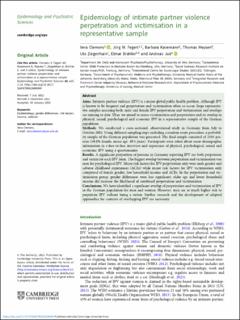Please use this identifier to cite or link to this item:
https://doi.org/10.21256/zhaw-30080Full metadata record
| DC Field | Value | Language |
|---|---|---|
| dc.contributor.author | Clemens, Vera | - |
| dc.contributor.author | Fegert, Jörg M. | - |
| dc.contributor.author | Kavemann, Barbara | - |
| dc.contributor.author | Meysen, Thomas | - |
| dc.contributor.author | Ziegenhain, Ute | - |
| dc.contributor.author | Brähler, Elmar | - |
| dc.contributor.author | Jud, Andreas | - |
| dc.date.accessioned | 2024-03-01T09:29:00Z | - |
| dc.date.available | 2024-03-01T09:29:00Z | - |
| dc.date.issued | 2023-04-19 | - |
| dc.identifier.issn | 2045-7960 | de_CH |
| dc.identifier.issn | 2045-7979 | de_CH |
| dc.identifier.uri | https://digitalcollection.zhaw.ch/handle/11475/30080 | - |
| dc.description | Erworben im Rahmen der Schweizer Nationallizenzen (http://www.nationallizenzen.ch) | de_CH |
| dc.description.abstract | Aims: Intimate partner violence (IPV) is a major global public health problem. Although IPV is known to be frequent and perpetration and victimisation often co-occur, large representative samples assessing both, male and female IPV perpetration and victimisation and overlaps are missing to date. Thus, we aimed to assess victimisation and perpetration and its overlap in physical, sexual, psychological and economic IPV in a representative sample of the German population. Methods: We conducted a cross-sectional, observational study in Germany from July to October 2021. Using different sampling steps including a random route procedure, a probability sample of the German population was generated. The final sample consisted of 2503 persons (50.2% female, mean age: 49.5 years). Participants were asked about socio-demographic information in a face-to-face interview and experience of physical, psychological, sexual and economic IPV using a questionnaire. Results: A significant proportion of persons in Germany reporting IPV are both perpetrator and victim for each IPV form. The biggest overlap between perpetration and victimisation was seen for psychological IPV. Major risk factors for IPV perpetration only were male gender and adverse childhood experiences (ACEs) while major risk factors for IPV victimisation only comprised of female gender, low household income and ACEs. In the perpetration and victimisation group, gender differences were less significant; older age and lower household income did increase the likelihood of combined perpetration and victimisation. Conclusions: We have identified a significant overlap of perpetration and victimisation of IPV in the German population for men and women. However, men are at much higher risk to perpetrate IPV without being a victim. Further research and the development of adapted approaches for contexts of overlapping IPV are necessary. | de_CH |
| dc.language.iso | en | de_CH |
| dc.publisher | Cambridge University Press | de_CH |
| dc.relation.ispartof | Epidemiology and Psychiatric Sciences | de_CH |
| dc.rights | http://creativecommons.org/licenses/by/4.0/ | de_CH |
| dc.subject | Epidemiology | de_CH |
| dc.subject | Gender differences | de_CH |
| dc.subject | Trauma | de_CH |
| dc.subject | Violence | de_CH |
| dc.subject | Humans | de_CH |
| dc.subject | Male | de_CH |
| dc.subject | Female | de_CH |
| dc.subject | Middle aged | de_CH |
| dc.subject | Cross-sectional study | de_CH |
| dc.subject | Risk factor | de_CH |
| dc.subject | Crime victim | de_CH |
| dc.subject | Intimate partner violence | de_CH |
| dc.subject | Bullying | de_CH |
| dc.subject.ddc | 362: Gesundheits- und Sozialdienste | de_CH |
| dc.title | Epidemiology of intimate partner violence perpetration and victimisation in a representative sample | de_CH |
| dc.type | Beitrag in wissenschaftlicher Zeitschrift | de_CH |
| dcterms.type | Text | de_CH |
| zhaw.departement | Soziale Arbeit | de_CH |
| zhaw.organisationalunit | Institut für Kindheit, Jugend und Familie (IKJF) | de_CH |
| dc.identifier.doi | 10.1017/S2045796023000069 | de_CH |
| dc.identifier.doi | 10.21256/zhaw-30080 | - |
| dc.identifier.pmid | 37073832 | de_CH |
| zhaw.funding.eu | No | de_CH |
| zhaw.issue | e25 | de_CH |
| zhaw.originated.zhaw | Yes | de_CH |
| zhaw.publication.status | publishedVersion | de_CH |
| zhaw.volume | 32 | de_CH |
| zhaw.publication.review | Peer review (Publikation) | de_CH |
| zhaw.author.additional | No | de_CH |
| zhaw.display.portrait | Yes | de_CH |
| Appears in collections: | Publikationen Soziale Arbeit | |
Files in This Item:
| File | Description | Size | Format | |
|---|---|---|---|---|
| 2023_Clemens-etal_Epidemiology-intimate-partner-violence_eps.pdf | 211.68 kB | Adobe PDF |  View/Open |
Show simple item record
Clemens, V., Fegert, J. M., Kavemann, B., Meysen, T., Ziegenhain, U., Brähler, E., & Jud, A. (2023). Epidemiology of intimate partner violence perpetration and victimisation in a representative sample. Epidemiology and Psychiatric Sciences, 32(e25). https://doi.org/10.1017/S2045796023000069
Clemens, V. et al. (2023) ‘Epidemiology of intimate partner violence perpetration and victimisation in a representative sample’, Epidemiology and Psychiatric Sciences, 32(e25). Available at: https://doi.org/10.1017/S2045796023000069.
V. Clemens et al., “Epidemiology of intimate partner violence perpetration and victimisation in a representative sample,” Epidemiology and Psychiatric Sciences, vol. 32, no. e25, Apr. 2023, doi: 10.1017/S2045796023000069.
CLEMENS, Vera, Jörg M. FEGERT, Barbara KAVEMANN, Thomas MEYSEN, Ute ZIEGENHAIN, Elmar BRÄHLER und Andreas JUD, 2023. Epidemiology of intimate partner violence perpetration and victimisation in a representative sample. Epidemiology and Psychiatric Sciences. 19 April 2023. Bd. 32, Nr. e25. DOI 10.1017/S2045796023000069
Clemens, Vera, Jörg M. Fegert, Barbara Kavemann, Thomas Meysen, Ute Ziegenhain, Elmar Brähler, and Andreas Jud. 2023. “Epidemiology of Intimate Partner Violence Perpetration and Victimisation in a Representative Sample.” Epidemiology and Psychiatric Sciences 32 (e25). https://doi.org/10.1017/S2045796023000069.
Clemens, Vera, et al. “Epidemiology of Intimate Partner Violence Perpetration and Victimisation in a Representative Sample.” Epidemiology and Psychiatric Sciences, vol. 32, no. e25, Apr. 2023, https://doi.org/10.1017/S2045796023000069.
Items in DSpace are protected by copyright, with all rights reserved, unless otherwise indicated.